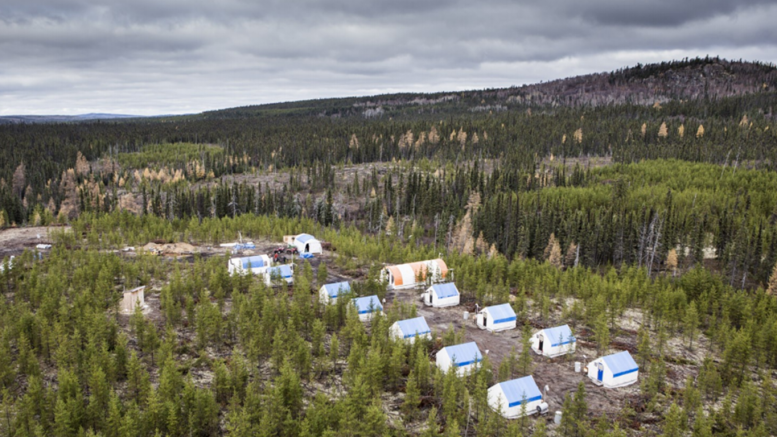VANCOUVER — Explorer Sirios Resources (TSXV: SOI; US-OTC: SIREF) has been toiling away for years in relative obscurity at its flagship Cheechoo gold project, 320 km north of Matagami, Que., but is gaining new prominence on the release of gold-rich drill intercepts and a subsequent influx of cash from Goldcorp (TSX: G; NSYE: GG).
The Cheechoo property covers 145 claims over 75 sq. km and sits next to Goldcorp’s Éléonore gold mine, which hit commercial production in mid-2015.

The Éléonore gold mine in the northeast corner of the Opinaca Reservoir in the James Bay region of Québec, Canada. Credit: Goldcorp
Sirios president and CEO Dominique Doucet recounts during an interview that progress at Cheechoo had slowed during the last market downturn, with the company struggling to finish a modest 5,000-metre drill program due to a lack of capital.
“The timing has been good on the release of our drill results, which are exciting,” Doucet says. “There has been a change in the mood for investment in the gold sector. Since around early March the feeling has improved, but I wouldn’t say it’s become bullish. Careful investors and funds are definitely looking for under-valued deals.”
During initial drilling of a lower-grade gold zone within a large, granitic intrusive, Sirios found hints of higher-grade material related to certain structures. The tonalite that hosts gold mineralization at Cheechoo is silicified and albite-rich, with moderate-to-strong parallel quartz veining.
But the story changed late last year when the company studied these potentially high-grade structural trends and their rock types.

Silicified tonalite outcrop near drill hole #1 on the Cheechoo property. Source: Sirios Resources.
Doucet says the Sirios team suspected they were probably drilling in the wrong direction, and so in the late-2015 program they changed the orientation and targeted the suspected northeast- and southwest-trending structures.
“We had intersected biotite schist previously, but it had been pretty minor. In hole 40 things changed. Our project tends to have low amounts of sulphide, and we saw the lithological results, and were aware that some gold zones at Éléonore were hosted in similar rocks.”
Hole 40 intersected an altered and mineralized biotite schist with 1–3% of pyrrhotite and arsenopyrite disseminated over a 36-metre unit, and five specks of visible gold were found within the schist and pegmatite.

Biotite schist over 36 metres with visible gold at the orange flag positions. Credit: Sirios Resources.
The results offered a promising structural target, and potential Éléonore analog, but assays in March were particularly strong, with hole 52 cutting 20.3 metres of 12.08 grams gold per tonne from 120 metres deep.
“Those are our most promising results to date, and there was a lot of visible gold,” Doucet says, noting that Sirios had been targeting the northeast- and southwest-trending structure starting within the metasediments and hitting gold mineralization at the contact with tonalite.
“We rushed the assay and also wanted to photograph the rocks out there, because it demonstrates that we have gold in both lithologies. It gives our geologists a new message, because normally gold deposits in granitic intrusives would be pretty low-grade and large tonnage. When you get gold in the adjacent metasediments, it indicates a world where you can have a high-grade deposit,” he says.
Sirios also drilled 10 wildcat holes 1 km northwest of Cheechoo’s mineralized halo, and cut three more intersects with visible gold around the geological contact between tonalite and metasedimentary rocks.
“There were numerous specks of gold, promising alteration and veins, so we’re quite excited, because it’s a new gold-bearing area outside of the main target,” Doucet says. “Even if the gold grades aren’t at that level of hole 52, we have excellent results because we’re finding targets that warrant follow-up.”

Lithology breakdown of hole #52. Visible gold at orange flag positions. Credit: Sirios Resources.
Sirios’ latest exploration results have attracted Goldcrop, which partially exercised its right to acquire up to 19.9% in the junior during a private placement, wherein it picked up 6.7 million units for $1.4 million. Overall Sirios has raised $5.5 million by issuing 17.5 million hard units at 20¢ and 6.7 million flow-through shares at 30¢. Each unit has one share and one half-warrant exercisable at 28¢ for 12 months.
Sirios plans to have structural geologists out in the field by the end of May to follow up on discoveries and devise a drill program that could total 10,000 metres. Sirios will likely split its attention between the wildcat area and precision follow-up around hole 52, and look at what it calls a “promising” gold-in-till anomaly along the western Éléonore project boundary.
“We don’t have a technical mixed team with Goldcorp at the moment, and it’s mainly other people that have pointed out similarities to Éléonore after seeing pictures of our core,” Ducet says.
“I can’t say today that it’s a similar situation, but we have started to see gold in the metasediments and some similarities with the biotite schist. It’s not that important to me, however, whether the discovery is similar to Éléonore or not. One mining camp can have a variety of deposits.”
Sirios shares have traded within a 52-week window of 7¢ to 51¢ per share, and skyrocketed 305% to start the year, en route to a 39.5¢-per-share close at press time. The company has 100 million shares outstanding.


Be the first to comment on "Sirios rethinks Cheechoo, wins Goldcorp’s interest"